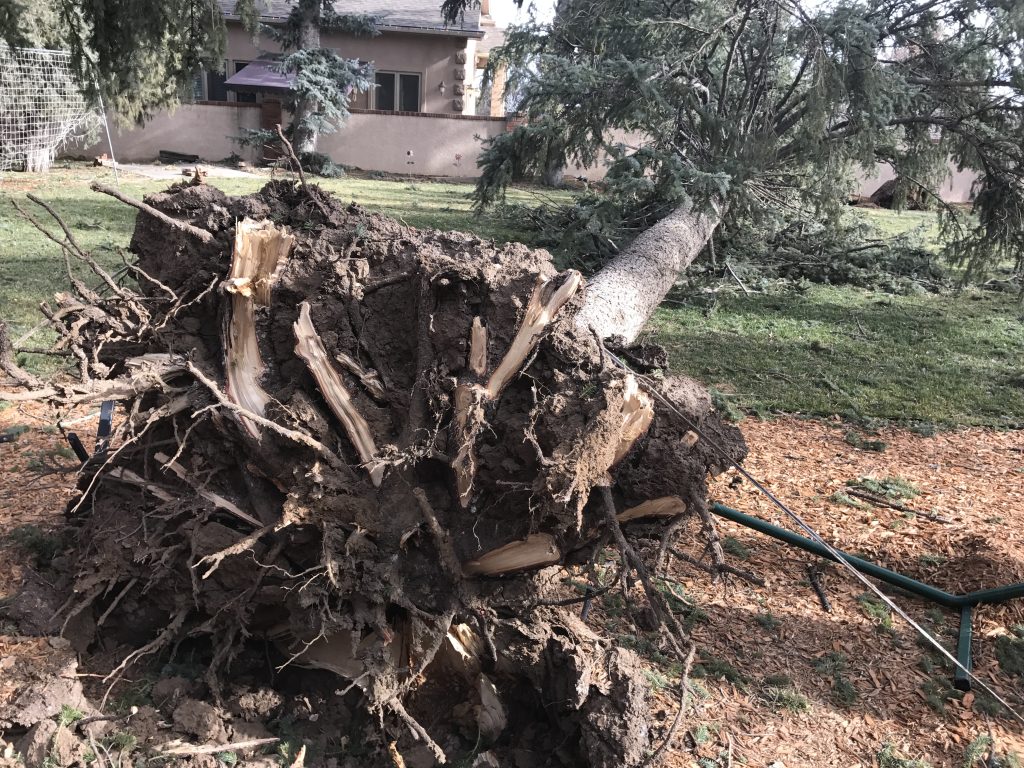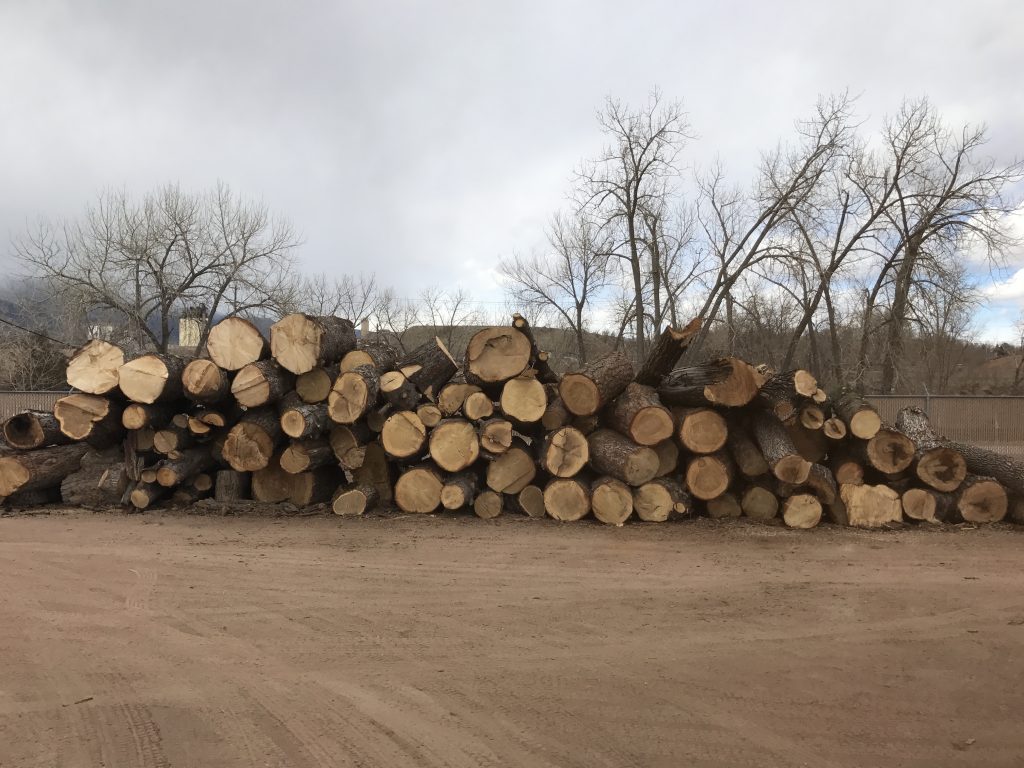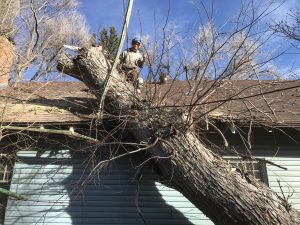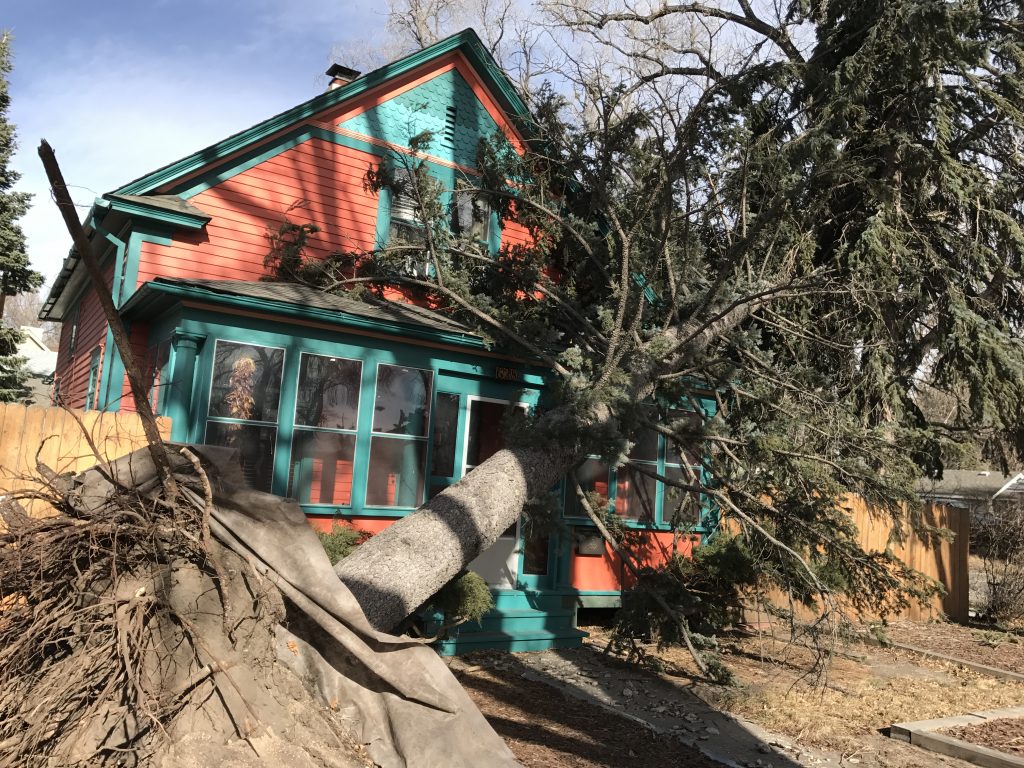January is a month that surprises us. It is one of the driest months of the year, but in many ways it is the most exciting. January 2017 has set many records for both Mountain High and the Pikes Peak region. Record breaking winds peaking over 100 mph hit on January 9 and 10 toppling trees throughout the region. Most of these were large spruce trees notorious for their shallow roots and full evergreen canopies. This wind event kept our crews in emergency mode for two weeks.
These strong powerful winds are not unusual in winter. The Colorado Climate Center at Colorado State University explains it this way: “Episodic strong winds are a part of life for all areas in the immediate lee (just east of) the high Rocky Mountain chain. Most of these strong winds are relatively brief but severe and are associated with rapidly descending air cascading over the crest of the Rockies and racing out to the plains. These ‘down slope wind storms’ are most common from late autumn into spring and accompany upper level disturbances in the strong winter-time jet stream. The highest winds ever in Colorado? Longs Peak holds the record at 201 mph set in the winter of 1981. Boulder, one of the nation’s windiest cities, clocked 147 mph in 1971.”
 January also offers many other records. The record low for January in Colorado Springs was -26 on January 31, 1951. The record high of 73 was set on January 2, 1997. In January of 1987 a record 28.7 inches of snow fell.
January also offers many other records. The record low for January in Colorado Springs was -26 on January 31, 1951. The record high of 73 was set on January 2, 1997. In January of 1987 a record 28.7 inches of snow fell.
~Update~
This is what 2 weeks worth of storm damage tree removals looks like – This is a lot of wood!





 Winter Watering:
Winter Watering: September and October have been extremely hot and dry. It’s important to water your plants well one last time before they go dormant. An added layer of mulch can help insulate roots and hold in moisture. Winter is one of Colorado’s harshest seasons. Cold and dry conditions threaten the biggest investment in your yard — your trees. Winter is the driest season in Colorado Springs, temperatures can drop well below zero and warm Chinook winds can batter our trees. Keep your trees healthy, avoid winter-kill and minimize insect and disease problems by having a winter tree care plan that includes watering and pruning. Winter is an ideal time to prune your trees. Our arborists can see dead wood and visualize tree structure in order to properly prune your trees.
September and October have been extremely hot and dry. It’s important to water your plants well one last time before they go dormant. An added layer of mulch can help insulate roots and hold in moisture. Winter is one of Colorado’s harshest seasons. Cold and dry conditions threaten the biggest investment in your yard — your trees. Winter is the driest season in Colorado Springs, temperatures can drop well below zero and warm Chinook winds can batter our trees. Keep your trees healthy, avoid winter-kill and minimize insect and disease problems by having a winter tree care plan that includes watering and pruning. Winter is an ideal time to prune your trees. Our arborists can see dead wood and visualize tree structure in order to properly prune your trees.

 “Our historic 118-year-old American Elm Tree, thanks to the TLC given by Mountain High Tree Care, is still going strong. Mountain High’s informed treatments have stopped problems as they have occurred, resulting in renewed vitality and healthier appearance.” ~ Dave Munger, Past President, Old North End Neighborhood.
“Our historic 118-year-old American Elm Tree, thanks to the TLC given by Mountain High Tree Care, is still going strong. Mountain High’s informed treatments have stopped problems as they have occurred, resulting in renewed vitality and healthier appearance.” ~ Dave Munger, Past President, Old North End Neighborhood. Populations of these two defoliating caterpillars continue to expand this year in the Colorado Springs area. Blue Spruce, Douglas Fir and White Fir are hosts to these insects. Larvae were observed hatching in early June and evidence of feeding on new growth is just starting to show up.
Populations of these two defoliating caterpillars continue to expand this year in the Colorado Springs area. Blue Spruce, Douglas Fir and White Fir are hosts to these insects. Larvae were observed hatching in early June and evidence of feeding on new growth is just starting to show up. Douglas-Fir tussock moth has been most prevalent in our landscape trees but is also in forested areas on Cheyenne Mountain and on Rampart Range Road. Spruce budworm has surged in forested areas such as Cheyenne Cañon, Cheyenne Mountain and along Rampart Range Road. It can also move into our landscape Spruce and Fir trees.
Douglas-Fir tussock moth has been most prevalent in our landscape trees but is also in forested areas on Cheyenne Mountain and on Rampart Range Road. Spruce budworm has surged in forested areas such as Cheyenne Cañon, Cheyenne Mountain and along Rampart Range Road. It can also move into our landscape Spruce and Fir trees.

